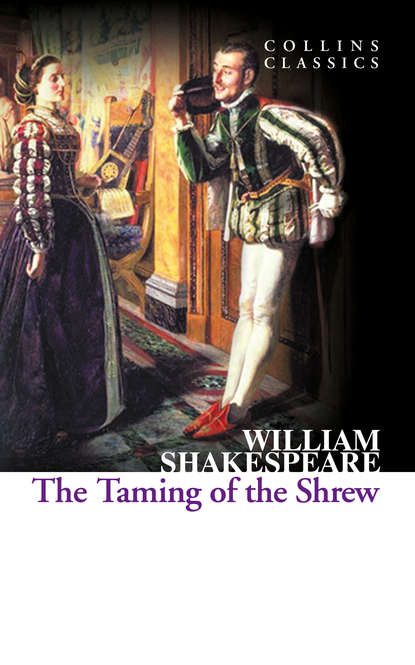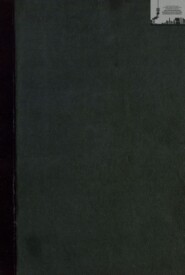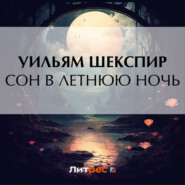По всем вопросам обращайтесь на: info@litportal.ru
(©) 2003-2024.
✖
The Taming of the Shrew
Настройки чтения
Размер шрифта
Высота строк
Поля
The Taming of the Shrew
William Shakespeare
HarperCollins is proud to present its incredible range of best-loved, essential classics.Bianca is beautiful and demure, with a plethora of wood-be suitors, but marriage is forbidden until her older sister Katherina finds a suitable match. The hitch? Fiery Katherina has sworn to deny the hand or demands of any would-be suitor. That is, until she meets her match in the wily Petrucio. As Katherina’s own sharp tongue is met by Petrucio’s feigned cruelty, the ‘shrew’ apparently capitulates. Or does she?This controversial comic tale, famously adapted into Cole Porter’s Kiss Me Kate and 10 Things I Hate About You, has divided and amused audiences for over 400 years in an unforgettable battle of wits.
THE ALEXANDER SHAKESPEARE
General Editor
R.B. Kennedy
Additional notes and editing
Mike Gould
THE TAMING OF THE SHREW
William Shakespeare
CONTENTS
Cover (#u5aabce2a-f090-5690-a57f-794a45dbbb95)
Title Page (#uea010ff5-cd35-5757-9859-9ac273e12c5e)
Prefatory Note (#ub5043d35-4e39-52e6-af2a-858a4be9d59a)
The Theatre in Shakespeare’s Day (#u659cbab0-8b8c-5e78-8b64-5f3793f55390)
Shakespeare: A Timeline (#u742b576a-1c8a-55b9-8635-7280a408f6e9)
Life & Times (#u752e2330-2828-5335-8cf9-f5a0601fb0b7)
Money in Shakespeare’s Day (#ucddd127e-2ca3-5e69-b449-9a50cbebb2a8)
Introduction (#u81dbf0bf-bd33-5926-96e0-7ed5ff11185f)
List of Characters (#u9c00bc3c-c9e8-5200-8f27-488050a16358)
Induction (#ud4426fad-d3c5-5429-939c-50f62b6222ed)
Scene I
Scene II (#udeff14fb-3eb1-5344-bbec-f0f855431c44)
Act One (#litres_trial_promo)
Scene I
Scene II (#litres_trial_promo)
Act Two (#litres_trial_promo)
Scene I
Act Three (#litres_trial_promo)
Scene I
Scene II (#litres_trial_promo)
Act Four (#litres_trial_promo)
Scene I
Scene II (#litres_trial_promo)
Scene III (#litres_trial_promo)
Scene IV (#litres_trial_promo)
Scene V (#litres_trial_promo)
Act Five (#litres_trial_promo)
Scene I
Scene II (#litres_trial_promo)
Shakespeare: Words and Phrases (#litres_trial_promo)
Copyright (#litres_trial_promo)
About the Publisher (#litres_trial_promo)
Prefatory Note
This Shakespeare play uses the full Alexander text. By keeping in mind the fact that the language has changed considerably in four hundred years, as have customs, jokes, and stage conventions, the editors have aimed at helping the modern reader – whether English is their mother tongue or not – to grasp the full significance of the play. The Notes, intended primarily for examination candidates, are presented in a simple, direct style. The needs of those unfamiliar with British culture have been specially considered.
Since quiet study of the printed word is unlikely to bring fully to life plays that were written directly for the public theatre, attention has been drawn to dramatic effects which are important in performance. The editors see Shakespeare’s plays as living works of art which can be enjoyed today on stage, film and television in many parts of the world.
An Elizabethan playhouse. Note the apron stage protruding into the auditorium, the space below it, the inner room at the rear of the stage, the gallery above the inner stage, the canopy over the main stage, and the absence of a roof over the audience.
The Theatre in Shakespeare’s Day
On the face of it, the conditions in the Elizabethan theatre were not such as to encourage great writers. The public playhouse itself was not very different from an ordinary inn-yard; it was open to the weather; among the spectators were often louts, pickpockets and prostitutes; some of the actors played up to the rowdy elements in the audience by inserting their own jokes into the authors’ lines, while others spoke their words loudly but unfeelingly; the presentation was often rough and noisy, with fireworks to represent storms and battles, and a table and a few chairs to represent a tavern; there were no actresses, so boys took the parts of women, even such subtle and mature ones as Cleopatra and Lady Macbeth; there was rarely any scenery at all in the modern sense. In fact, a quick inspection of the English theatre in the reign of Elizabeth I by a time-traveller from the twentieth century might well produce only one positive reaction: the costumes were often elaborate and beautiful.
Shakespeare himself makes frequent comments in his plays about the limitations of the playhouse and the actors of his time, often apologizing for them. At the beginning of Henry V the Prologue refers to the stage as ‘this unworthy scaffold’ and to the theatre building (the Globe, probably) as ‘this wooden O’, and emphasizes the urgent need for imagination in making up for all the deficiencies of presentation. In introducing Act IV the Chorus goes so far as to say:
… we shall much disgrace
William Shakespeare
HarperCollins is proud to present its incredible range of best-loved, essential classics.Bianca is beautiful and demure, with a plethora of wood-be suitors, but marriage is forbidden until her older sister Katherina finds a suitable match. The hitch? Fiery Katherina has sworn to deny the hand or demands of any would-be suitor. That is, until she meets her match in the wily Petrucio. As Katherina’s own sharp tongue is met by Petrucio’s feigned cruelty, the ‘shrew’ apparently capitulates. Or does she?This controversial comic tale, famously adapted into Cole Porter’s Kiss Me Kate and 10 Things I Hate About You, has divided and amused audiences for over 400 years in an unforgettable battle of wits.
THE ALEXANDER SHAKESPEARE
General Editor
R.B. Kennedy
Additional notes and editing
Mike Gould
THE TAMING OF THE SHREW
William Shakespeare
CONTENTS
Cover (#u5aabce2a-f090-5690-a57f-794a45dbbb95)
Title Page (#uea010ff5-cd35-5757-9859-9ac273e12c5e)
Prefatory Note (#ub5043d35-4e39-52e6-af2a-858a4be9d59a)
The Theatre in Shakespeare’s Day (#u659cbab0-8b8c-5e78-8b64-5f3793f55390)
Shakespeare: A Timeline (#u742b576a-1c8a-55b9-8635-7280a408f6e9)
Life & Times (#u752e2330-2828-5335-8cf9-f5a0601fb0b7)
Money in Shakespeare’s Day (#ucddd127e-2ca3-5e69-b449-9a50cbebb2a8)
Introduction (#u81dbf0bf-bd33-5926-96e0-7ed5ff11185f)
List of Characters (#u9c00bc3c-c9e8-5200-8f27-488050a16358)
Induction (#ud4426fad-d3c5-5429-939c-50f62b6222ed)
Scene I
Scene II (#udeff14fb-3eb1-5344-bbec-f0f855431c44)
Act One (#litres_trial_promo)
Scene I
Scene II (#litres_trial_promo)
Act Two (#litres_trial_promo)
Scene I
Act Three (#litres_trial_promo)
Scene I
Scene II (#litres_trial_promo)
Act Four (#litres_trial_promo)
Scene I
Scene II (#litres_trial_promo)
Scene III (#litres_trial_promo)
Scene IV (#litres_trial_promo)
Scene V (#litres_trial_promo)
Act Five (#litres_trial_promo)
Scene I
Scene II (#litres_trial_promo)
Shakespeare: Words and Phrases (#litres_trial_promo)
Copyright (#litres_trial_promo)
About the Publisher (#litres_trial_promo)
Prefatory Note
This Shakespeare play uses the full Alexander text. By keeping in mind the fact that the language has changed considerably in four hundred years, as have customs, jokes, and stage conventions, the editors have aimed at helping the modern reader – whether English is their mother tongue or not – to grasp the full significance of the play. The Notes, intended primarily for examination candidates, are presented in a simple, direct style. The needs of those unfamiliar with British culture have been specially considered.
Since quiet study of the printed word is unlikely to bring fully to life plays that were written directly for the public theatre, attention has been drawn to dramatic effects which are important in performance. The editors see Shakespeare’s plays as living works of art which can be enjoyed today on stage, film and television in many parts of the world.
An Elizabethan playhouse. Note the apron stage protruding into the auditorium, the space below it, the inner room at the rear of the stage, the gallery above the inner stage, the canopy over the main stage, and the absence of a roof over the audience.
The Theatre in Shakespeare’s Day
On the face of it, the conditions in the Elizabethan theatre were not such as to encourage great writers. The public playhouse itself was not very different from an ordinary inn-yard; it was open to the weather; among the spectators were often louts, pickpockets and prostitutes; some of the actors played up to the rowdy elements in the audience by inserting their own jokes into the authors’ lines, while others spoke their words loudly but unfeelingly; the presentation was often rough and noisy, with fireworks to represent storms and battles, and a table and a few chairs to represent a tavern; there were no actresses, so boys took the parts of women, even such subtle and mature ones as Cleopatra and Lady Macbeth; there was rarely any scenery at all in the modern sense. In fact, a quick inspection of the English theatre in the reign of Elizabeth I by a time-traveller from the twentieth century might well produce only one positive reaction: the costumes were often elaborate and beautiful.
Shakespeare himself makes frequent comments in his plays about the limitations of the playhouse and the actors of his time, often apologizing for them. At the beginning of Henry V the Prologue refers to the stage as ‘this unworthy scaffold’ and to the theatre building (the Globe, probably) as ‘this wooden O’, and emphasizes the urgent need for imagination in making up for all the deficiencies of presentation. In introducing Act IV the Chorus goes so far as to say:
… we shall much disgrace

















